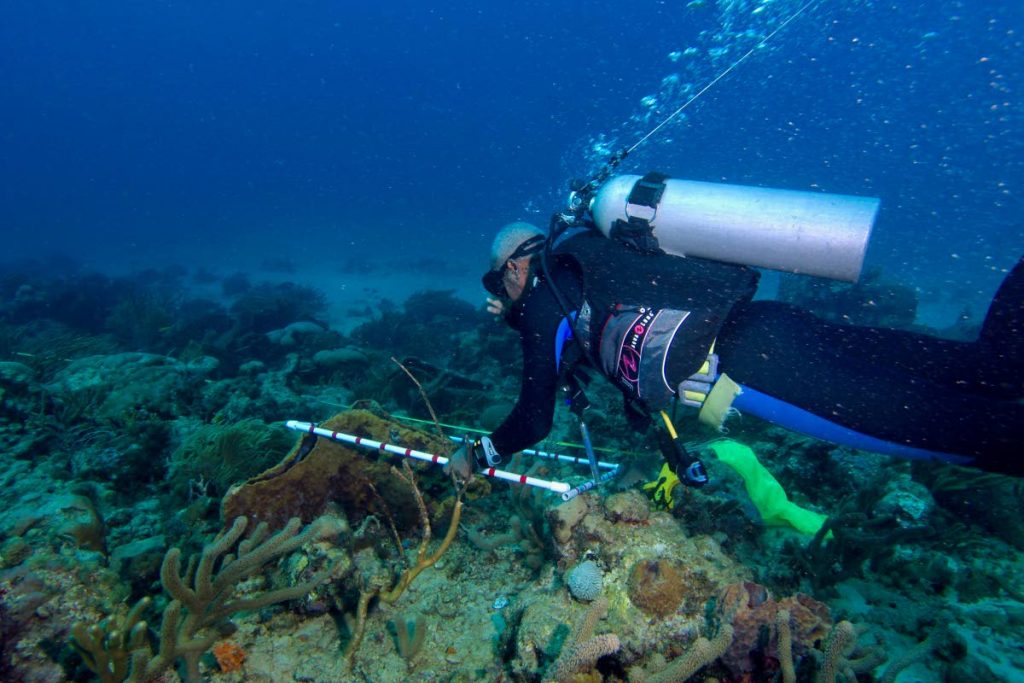Building ocean resilience

Dr Anjani Ganase, coral reef ecologist, Institute of Marine Affairs.
The pandemic gives us time to pause, to reconsider relationships with people but more importantly, the relationship with the earth and ocean. What should we be doing while our livelihoods, our economies are on pause? How can we make sure our islands can bounce back?
Our history of disturbance
As we celebrate World Oceans Day –June 8 – very little of the marine world remains unaffected by human activities, and this small fraction is rapidly shrinking as climate change becomes more apparent in the most remote areas of the world. Forty-one percent of our marine ecosystems are severely impacted; these consist mostly of nearshore habitats such as coral reefs, mangrove forests, rocky reefs and seagrass beds. The regions of the world where most severe human impacts are observed include the Eastern Caribbean, the North Sea, and the South and East China Sea, all of which have been affected by over-fishing and land-based sources of pollution.
While land-based agricultural runoff is significant in nearshore environment, climate change has the larger geographic span of influence followed closely by commercial fishing. These activities have accelerated over the last fifty to hundred years, and researchers also note that there are cumulative effects. While marine ecosystems go through natural cycles of environmental disturbances (hurricanes, earthquakes etc), the combined constant pressures of human disturbances on top of the natural disturbance events result in many marine ecosystems being pushed beyond a threshold for recovery, as conditions are no longer conducive for survival. These consequences come full circle as the ecosystem losses result in a loss of well-being to the dependent communities.
Ecological resilience
A healthy and resilient ocean is one that is readily able to return to a healthy state following disturbance events or even resist the impact of the disturbance depending on its severity. For example, healthy mangrove forests can effectively reduce the damages of severe storm surge because the thick interconnected root systems stabilise the shore and reduce wave and wind forces.
The same root systems create a well-protected refuge for nurseries. Real estate, homes and properties inland are protected by mangrove forests.
When healthy forests are damaged, their density might still sustain the habitat and its hydrodynamics as well as provide for regrowth. However, as mangrove forests become more degraded and fragmented, while they may still provide some services, they are less likely to recover from disturbances.
Trinidad and Tobago is home to over 93 square kilometres (just over the size of Anguilla) of mangrove forests that protect and sustain a number of coastal communities and infrastructure.
Similarly, coral reefs can be resilient to disturbances such as global warming and mass bleaching events. Reefs with high biodiversity and functional redundancy of organisms do a better job at recovering from a mass coral die off; but it depends on several other factors.
Because space is limited on a reef, when corals die, they are quickly occupied by rapid growing turf and macroalgae. Important grazers, such as parrotfish, surgeonfish and sea urchin feed on the algae and clear surfaces for new corals to be recruited.
A resilient reef must also have a good connection with other reefs, to replenish stocks of fish, corals and among many others.
Monitoring of Tobago’s coral reefs by the Institute of Marine Affairs (IMA) suggests that reefs found in northeast Tobago may be more resilient owing to lower impacts of land-based pollution and a greater stock of marine grazers to assist in recovery.
However, past studies also suggests that the Tobago’s coral reefs are quite isolated with limited coral recruitment.
To build ocean resilience to climate change, we must reduce the number of chronic impacts, largely related to human activities, that accumulate and inhibit ecosystems. This is done through coastal zone management and regulating upstream pollution.
At the same time, we must manage the marine resources sustainably, with areas protected to facilitate resupply. This is done through marine spatial planning and management of important coral reefs, seagrass, and mangroves.
Active restoration, which consists of activities such as replanting needed to jump start the recovery process, must be considered under circumstances where natural recovery is limited because of isolation or owing to the long history of disturbance.
This has been attempted for many coral species throughout the Caribbean, as well as for important reef species.
Social resilience
Healthy marine habitats support a range of livelihoods, economies and culture on islands. Communities, in turn, must maintain conscious use of marine habitats and conserve environmental conditions so that ocean ecosystems can continue to be productive. Climate change is expected to have more detrimental impacts to certain marine ecosystems and will exacerbate the vulnerability of ocean dependent communities.
Coastal communities for example, are directly at risk of extreme storm surges as a result of sea level rise, and indirectly through loss of livelihood because of a mass coral bleaching event. Poorer communities will be more severely affected.
An additional measure of vulnerability is the adaptive capacity of the community, which is the ability to mitigate or adapt to disturbances, such as switching from wild fish catch to aquaculture or diversifying the job market to include less ocean dependent jobs. Climate change is especially difficult for people to respond to as it is considered a long-term risk that may be less visible.
Unfortunately, most Caribbean countries are extremely vulnerable to the effects of climate change. Some may say that its almost too late to develop social resilience to prepare for warmer future, as the impacts of climate change are already being felt. Nevertheless, we must develop strategies to allow communities to recover or adapt to the shocks to livelihoods as a result of climate-related impacts.
Building blue resilience
The need to restore ecological and social resilience is urgent. The economies of many island nations are halted because of the covid19 pandemic; no tourism means no income for most of the Caribbean.
Yet this time may be regarded as the opportunity to consider a future affected by climate change: more severe hurricanes, droughts, and events – such as the loss of coral reefs – which will further stifle jobs and livelihoods.
One Caribbean island nation is already showing the way. Grenada, in collaboration with UNEP, is using the global lockdown to climate-proof the cities of St George’s and Grenville. The project, in partnership with New York University and commissioned by the Green Climate Fund (GCF), uses strategies to improve their coastal and maritime infrastructure with both engineering and ecosystem-based solutions. Citizens are being upskilled and trained in disaster preparedness to develop a more adaptable, smarter and diverse workforce.
The project will also build ecological resilience of sensitive ecosystems, by actively restoring crucial marine habitats such as coral reefs, while managing upstream watersheds to prevent river contamination from sewage. The work done in Grenada is a pilot for what can be done on other islands.
Here in TT, the IMA is also looking into strategies during the UN Ocean Decade for Sustainable Development, where ocean and socio-economic resilience are complementary and integrated. As advisers on national policies concerning the marine environment, the IMA plays a critical role in developing policies and plans for responsible ocean use and management, such as the Draft National Integrated Coastal Zone Policy Framework (2020) and the Water Pollutions Rules (2019) that will improve our ocean resilience.
The IMA is also currently involved in the development of the local mariculture industry (culture of marine organisms) for commercially-important fish species to offset the pressures of commercial fishing, as well as building our capacity to conduct and advise on coral reef restoration to boost the resilience of Tobago’s coral reefs. .


Comments
"Building ocean resilience"